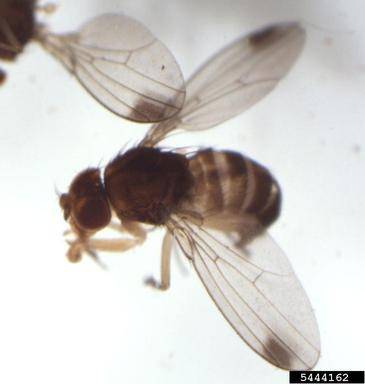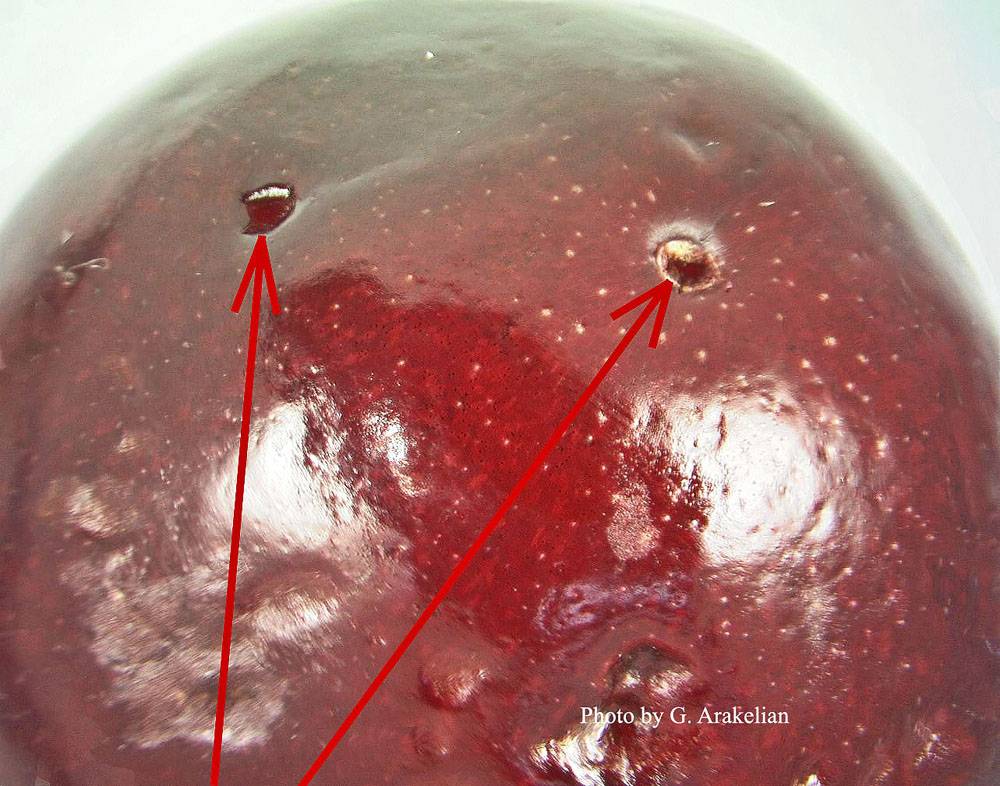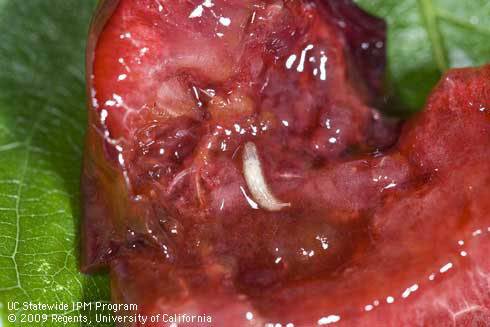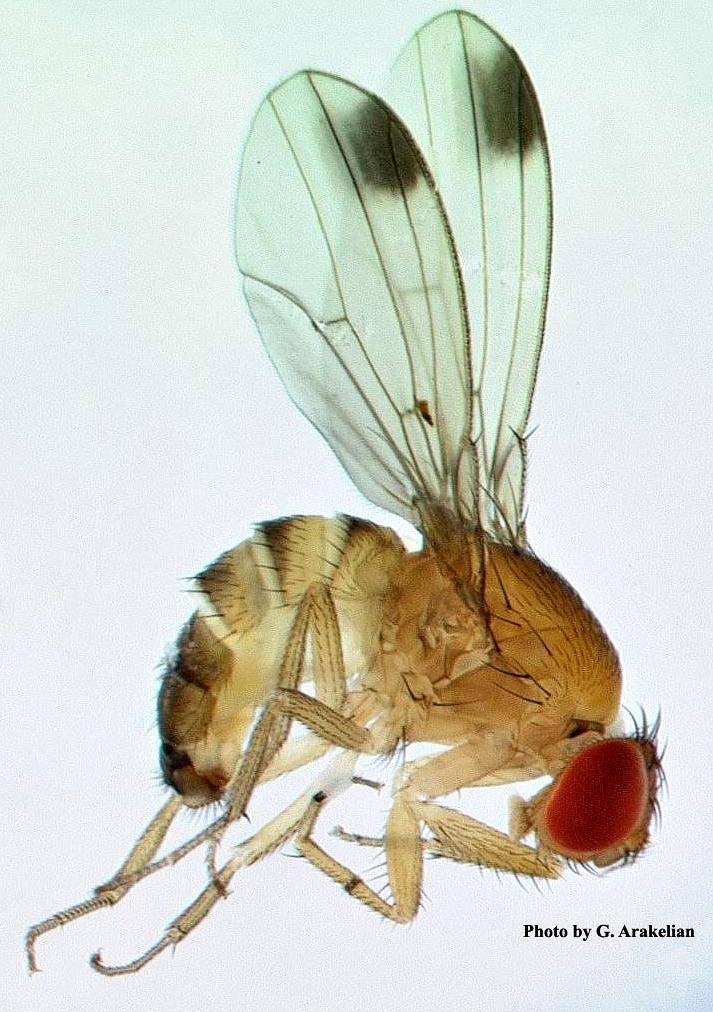Background | Habitat | Origin | Introduction and Spread | Impacts | Identification | Prevention | Control | Occurrences | New York Distribution Map
Background

The spotted wing drosophila (SWD), Drosophila suzukii, is an invasive vinegar fly. The fly is small (about 2-3mm in size) with a pale body and bright red eyes. Male SWD have a black spot near their wingtip and black bands on their front legs, which may help to distinguish them from other look-alike vinegar flies. This species of fly was first observed in the United States in California in 2008; it was found in New England in 2011. SWD lay their eggs in ripe or ripening fruit and berries. When the larvae hatch, they consume the fruit leaving it deformed. Hannah
Habitat
SWD affects many fruit and berries, including cherries, peaches, plums, pears, apples, raspberries, blackberries, strawberries, grapes, blueberries, and tomatoes. The insect also can infest non-commercial hosts such as crabapple, autumn olive, Japanese yew, beach plum, and wild rose. It not only infects already ripened fruit, but can affect fruit in the earlier stages of development as well. SWD are seen more in moderate climates and prefer the early summer or fall when temperatures are cooler (approximately 68° F). Adults will hibernate when temperatures drop to 40°F. In freezing temperatures, the larvae usually cannot survive.
Origin
Spotted wing drosophila are native to Southeast Asia.
Introduction and Spread
Various fruit crops will develop and ripen at different times throughout the growing season. The SWD will take advantage of this and move from one crop to another as the season progresses. Additionally, infested fruit may be shipped from different parts of the country and sold at markets, which increases the spread of SWD. This insect has a high reproductive rate. Within one year, the SWD can complete at least 15 generations. During the 2-9 weeks time frame that adults live, a female can lay 100-600 eggs in fruit.
Impact
When female SWD lay their eggs on the fruit, a small, barely visible scar is left on the fruit’s surface. Within a couple hours or a few days the larvae may begin to hatch and feed on the fruit from the inside, which eventually causes the fruit to collapse and look deformed. Fruit may start looking misshapen within 2-13 days after becoming infested. Secondary pests, such as molds and bacteria, may also further infect the fruit, exacerbating the damage. Since SWD look very similar to other common vinegar flies, many populations of SWD go unnoticed and untreated until a large infestation occurs.
In 2009, yield loss from SWD was estimated to be in a range from zero up to 80% (Walsh et al. 2011). SWD is a big concern in areas located on the western coast of the United States, such as California, Oregon, and Washington. There, a large proportion of the nation’s commercial production of raspberry, blackberry, cherry, strawberry, and blueberry occurs. In the Northeast, SWD has affected raspberry and blackberry the most. Peaches and grapes are also affected in the Northeast. It is still unknown how this species will overwinter and if earlier season crops are of greater risk to be infested in the future (Demchak et al. 2012).


Identification
SWD is about 2-3 mm in size, with bright red eyes. The majority of the insect’s body is a pale brown with black horizontal stripes on the abdomen region. You can distinguish a male SWD from other vinegar flies in the Drosophila genus by a dark spot along the front edge of the wing near the wingtip. This spot may be missing on some SWD males, but another defining characteristic for males is the presence of two black bands on each front leg. Female SWD tend to have a saw-like ovipositor, larger than that of other species. Otherwise they look very similar to common vinegar flies. The white larvae of SWD are small and cylinder-shaped.

Prevention
Growers of fruits that are commonly affected by SWD are encouraged to inspect their crops frequently. Screens or growing inside a greenhouse have been used for individual plant protection to exclude the flies in some cases. However, this method may not be as suitable or practical for many growers and producers. Bait traps or lures to detect fruit flies may also be utilized to monitor the presence of SWD. Since females have fewer distinguishing characteristics than males, it is recommended to monitor the male populations to avoid confusion with other species. Traps should be placed in a field right before the fruit starts to turn color. For more information on making your own traps and placement of traps, refer to the Pennsylvania State University monitoring fact sheet, (Demchak et al. 2012).
Control
To control already-established infestations of SWD, remove all ripe and cull fruit when harvesting. Also, try to pick the fruit as soon as possible and do not leave harvested fruit exposed for long periods of time. Any fruit that has become infested should be promptly removed and disposed of properly. All damaged fruit should be buried, covered with plastic, or disposed of in a closed container. Leaving the infested fruit to decompose in the field where they dropped will give eggs and larvae still present on the fruit a chance to fully develop into mature insects causing the population on SWD to increase.
There are some biological control agents, such as parasitoids that affect species within the Drosophila genus (Dubuffett et al. 2009). Researchers at Oregon State University are exploring biological control methods specifically for SWD. However, it is still unknown if these predators are a reliable biocontrol method at this time. Some pesticides that are approved may be applied across fields for SWD control. These treatments may need to be reapplied almost every 1-2 weeks. Three groups of pesticides, the pyrethroids, spinosyns, and organophosphates have been found to be effective. Since SWD has such a high reproductive rate, with multiple generations per year, it is suggested to use a variety of pesticides to reduce chemical resistance evolving within this species (Demchak et al. 2012). Contact your local Cornell Cooperative Extension office for more information on pesticides before use and always follow the directions on the label.
Occurrences
SWD has been documented in Japan, China, Korea, Thailand, India, Spain, and Hawaii. SWD was first observed in California in 2008. In 2011, SWD was found in the Northeast in Pennsylvania.
New York Distribution Map
This map shows confirmed observations (green points) submitted to the NYS Invasive Species Database. Absence of data does not necessarily mean absence of the species at that site, but that it has not been reported there. For more information, please visit iMapInvasives.




.jpg)